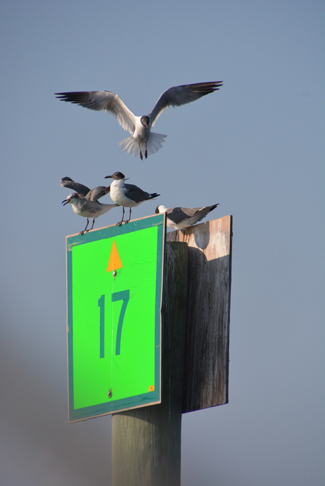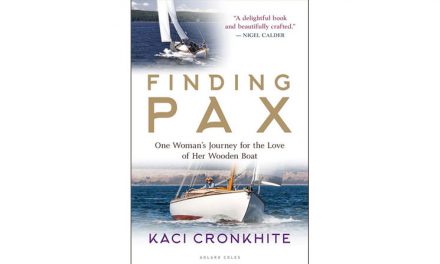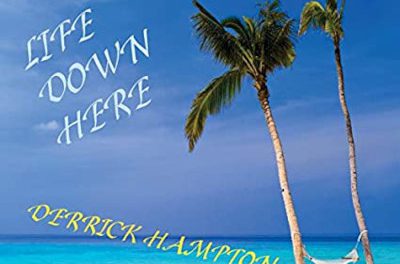
Contributor Shirley Jones of Ariose sent this Mail Buoy photo and reports that, after her recent cruise, she’s not sure whether the thousands of markers along the Intracoastal Waterway are there to serve the mariners or the birds
FROM TURKEYS TO DOLPHINS
I just read Jeremy’s article about the Hospice Turkey Shoot (“Chasing Silver in a Good Cause,” August 2017). Stu Polhamus is a 3-time Dolphin 24 owner (current is Equinox) and a long-time Turkey Shoot competitor. This past weekend he was a judge up at the Camden (Maine) Classic Cup regatta—51 good old boats including 5 Dolphins racing for the New England Championships. Thought you might be interested in this story. Dan Spurr knows something about these boats.
–Ron Breault, Old Lyme, Connecticut
Editor’s note on the above: Ron Breault is owner of dolphin24.org, a “website for Dolphin 24 owners and others interested in this classic design.” It’s a fascinating, comprehensive site about this ground-breaking boat that got its start in 1958 when George O’Day and Olin Stephens had a conversation. In fact, as part of his research for this site, Ron interviewed Olin Stephens (age 98 at the time) in 2007 in his New Hampshire home. Ron also gathered info from Heart of Glass, the definitive book on the history of fiberglass sailboat building by our own Dan Spurr. In addition to the Turkey Shoot, the Dolphin 24 has won the Singlehanded Transpac race and numerous examples race regularly around the country every year, notably in Maine’s Camden Classic Cup. In addition to Ron’s excellent website, more info on the Dolphin 24 can be found in an article that Dyke Williams wrote for us back in our September 2005 issue, “The Yankee Dolphin.” Click here to read it.
NO NEED FOR SPAGHETTI COMPLAININ’
I just had to chime in on the GOB Newsletter discussion of a tangle of lines resulting when one leads halyards and other lines to the cockpit. I’ll get all dogmatic and say simply: anyone complaining about spaghetti is simply not managing their lines very well.
–Paul Brogger, Olympia, Washington
 DISABLED BOATERS UNITE!
DISABLED BOATERS UNITE!
Greetings. We are not only good old boat owners but also good old boaters. Further, my wife is partially disabled with multiple sclerosis (MS). We keep our sailboat in Placida, Florida and spend three months a year on it during the winter season. Our primary residence is in Tennessee. For the past two seasons, much of our boating time has been spent at anchor in Charlotte Harbor.
While Charlotte Harbor is very beautiful, we would like to do more cruising along the SW Florida coast, the Keys, Dry Tortugas, and the Bahamas. These are places we frequented as younger sailors but are finding more difficult to access as age and disability move on.
We wonder if there are any boating clubs for senior and/or disabled boaters that specialize in group cruising activities. For example, due to my wife’s disability, I essentially singlehand the boat. It would be great to find a boating group whose members are interested in cruising on each other’s boats to provide that small amount of extra help, knowledge, and comradery to make the trip safe and fun. Also, joint cruising activities by multiple boats would also be very effective in providing emotional and physical support for disabled folks who would otherwise not attempt a cruise.
We know that there are many great yacht/boating clubs that sponsor group cruising activities. We, however, feel that our particular age and disability limitations would be better suited to a group of boaters with similar needs. We read once that a neurologist combined his medical and recreational boating skills to bring people with MS on sailing outings and thought it was a great idea.
Is anyone aware of existing boating clubs for sailors with special needs, or willing to start one? If so, please feel free to contact us at vulcan213@gmail.com.
–Brian and Carol McMahon, Spring City, Tennessee
FLIR RESPONDS
In the August issue of The Dogwatch, we Put it to the Readers with a story from Gary Bratton about erroneous readings on his depth sounder. –Eds.
I sent my The Dogwatch article to the FLIR technical support team in the UK (FLIR owns Raymarine) asking them if the water surface turbulence caused by the heavy rain could have caused the erroneous depth readings I saw. They responded with the following:
Thank you for the copy of the article, most interesting reading and excellent description of the suddenness and surprise that things can change so dramatically and in such short time, that an apparently safe and secure situation can be deteriorate to a moment of near panic. Very interesting to hear about the performance of the depth system, you did not mention what type it was, but the behavior is quite odd.
It could quite conceivably happen that the storm whipped up a turbulent sea, triggering swirling silt in the water from surface water run-off from the land, or maybe stirring up a silty or sandy seabed, would add a lot of sediment into the water. Either of those events can impact the performance of a depth system by creating false echoes leading to loss of accurate depth measurement. Another possibility is heavy rain causing air entrainment in the water surface – possibly then stirred up by the wave action. This could be rather like the wash of a vessel passing close ahead, which could also trigger phantom returns in the depth sounder depending on the propeller wash or cavitation in the water. You can create this effect simply by following close astern a motor vessel. Depth measurement can also be affected by mixtures of fresh and salt water as well as differential temperatures of water layers. For example, in a fjord, there is often a mixture of fresh water runoff from the land mixing with salt sea water. These mixtures can combine in layers, and may also be layered by temperature too. These layers then also create false echoes — an issue well known to submariners, who like to hide their vessels underneath a temperature or brackish water interface, thereby concealing their presence.
–Gary Bratton, Green Cove Springs, Florida
NEW GARY BRATTON-THEORY SUBSCRIBER
We were caught in a 40-knot squall in Chesapeake Bay in about 15 feet of water. I let the boat drift bare pole. We draw 4 feet and the alarm was set for 5 feet. As the squall hit and waves rocked us the alarm was sounding. There was nothing I could do so I turned it off and awaited pounding on the bottom. It never happened. I still can’t figure why the alarm sounded and will now subscribe to Gary Bratton’s rain noise theory.
For what it’s worth: the transducer is mounted on the lee side of the keel during this storm and it’s the kind that transmits through the hull.
–Bill McLean, Norfolk, Virginia





